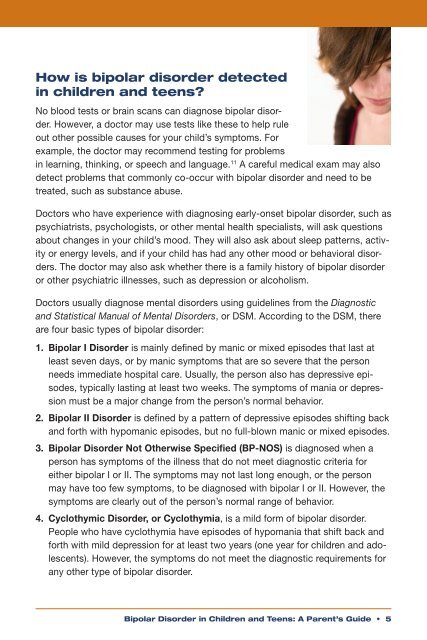Bipolar Disorder in Children and Teens: A Parent's Guide (PDF)
Bipolar Disorder in Children and Teens: A Parent's Guide (PDF)
Bipolar Disorder in Children and Teens: A Parent's Guide (PDF)
Create successful ePaper yourself
Turn your PDF publications into a flip-book with our unique Google optimized e-Paper software.
How is bipolar disorder detected<strong>in</strong> children <strong>and</strong> teens?No blood tests or bra<strong>in</strong> scans can diagnose bipolar disorder.However, a doctor may use tests like these to help ruleout other possible causes for your child’s symptoms. Forexample, the doctor may recommend test<strong>in</strong>g for problems<strong>in</strong> learn<strong>in</strong>g, th<strong>in</strong>k<strong>in</strong>g, or speech <strong>and</strong> language. 11 A careful medical exam may alsodetect problems that commonly co-occur with bipolar disorder <strong>and</strong> need to betreated, such as substance abuse.Doctors who have experience with diagnos<strong>in</strong>g early-onset bipolar disorder, such aspsychiatrists, psychologists, or other mental health specialists, will ask questionsabout changes <strong>in</strong> your child’s mood. They will also ask about sleep patterns, activityor energy levels, <strong>and</strong> if your child has had any other mood or behavioral disorders.The doctor may also ask whether there is a family history of bipolar disorderor other psychiatric illnesses, such as depression or alcoholism.Doctors usually diagnose mental disorders us<strong>in</strong>g guidel<strong>in</strong>es from the Diagnostic<strong>and</strong> Statistical Manual of Mental <strong>Disorder</strong>s, or DSM. Accord<strong>in</strong>g to the DSM, thereare four basic types of bipolar disorder:1. <strong>Bipolar</strong> I <strong>Disorder</strong> is ma<strong>in</strong>ly def<strong>in</strong>ed by manic or mixed episodes that last atleast seven days, or by manic symptoms that are so severe that the personneeds immediate hospital care. Usually, the person also has depressive episodes,typically last<strong>in</strong>g at least two weeks. The symptoms of mania or depressionmust be a major change from the person’s normal behavior.2. <strong>Bipolar</strong> II <strong>Disorder</strong> is def<strong>in</strong>ed by a pattern of depressive episodes shift<strong>in</strong>g back<strong>and</strong> forth with hypomanic episodes, but no full-blown manic or mixed episodes.3. <strong>Bipolar</strong> <strong>Disorder</strong> Not Otherwise Specified (BP-NOS) is diagnosed when aperson has symptoms of the illness that do not meet diagnostic criteria foreither bipolar I or II. The symptoms may not last long enough, or the personmay have too few symptoms, to be diagnosed with bipolar I or II. However, thesymptoms are clearly out of the person’s normal range of behavior.4. Cyclothymic <strong>Disorder</strong>, or Cyclothymia, is a mild form of bipolar disorder.People who have cyclothymia have episodes of hypomania that shift back <strong>and</strong>forth with mild depression for at least two years (one year for children <strong>and</strong> adolescents).However, the symptoms do not meet the diagnostic requirements forany other type of bipolar disorder.<strong>Bipolar</strong> <strong>Disorder</strong> <strong>in</strong> <strong>Children</strong> <strong>and</strong> <strong>Teens</strong>: A Parent’s <strong>Guide</strong> • 5



